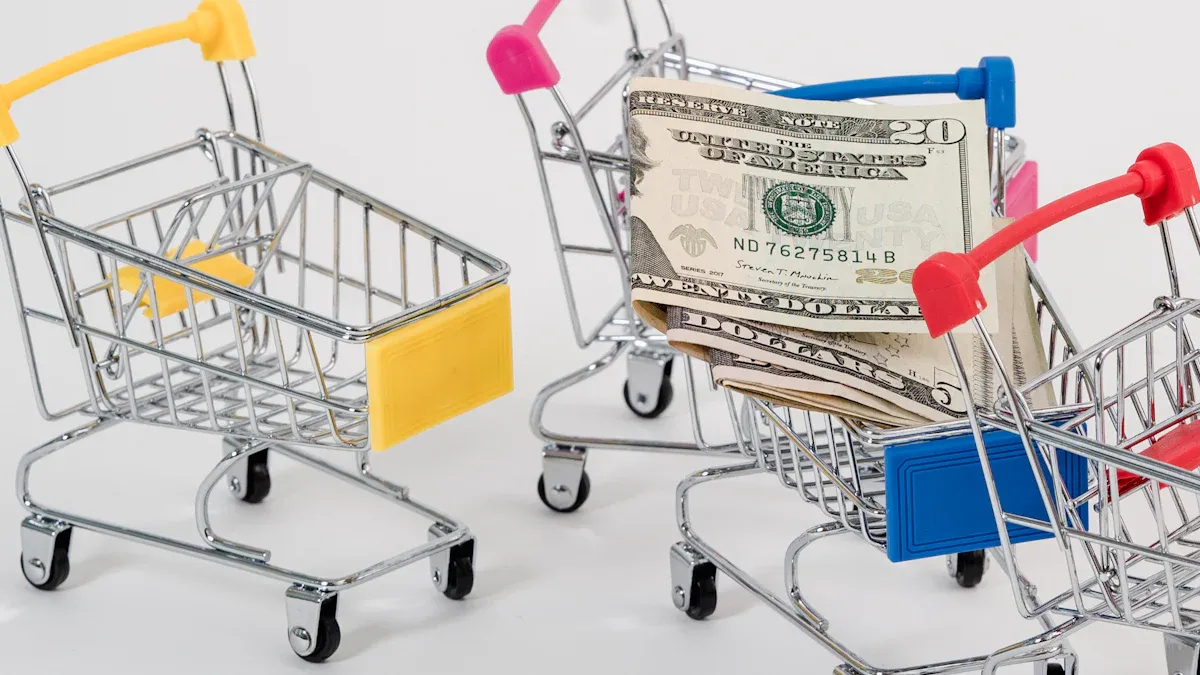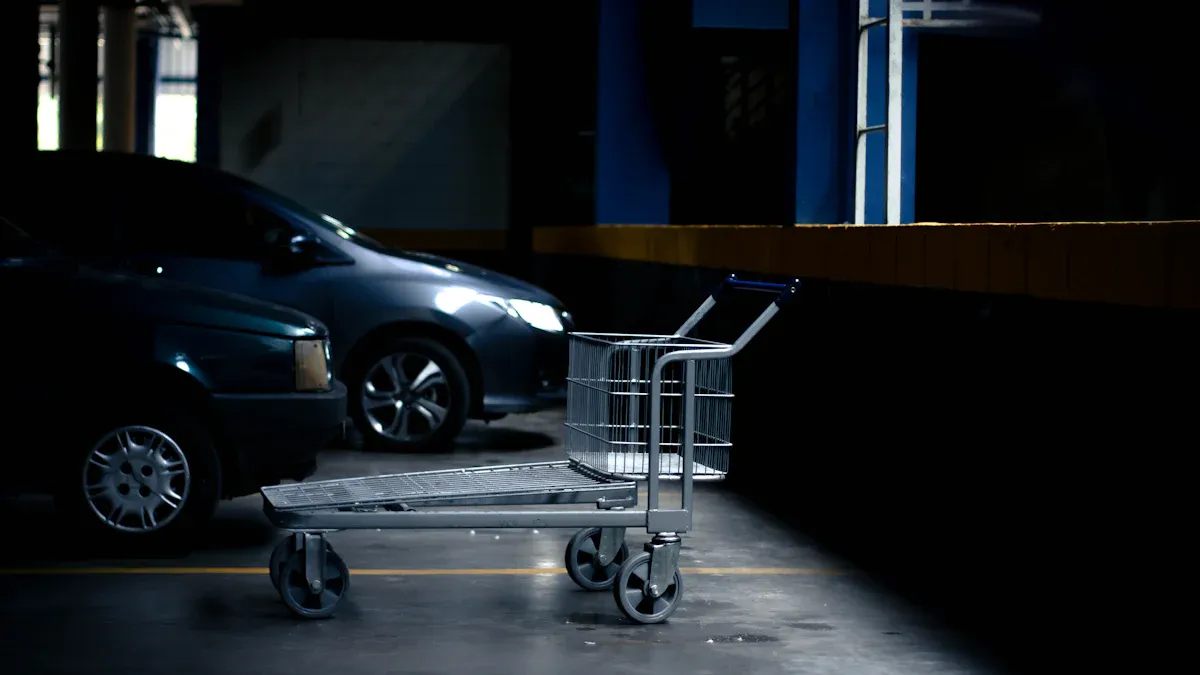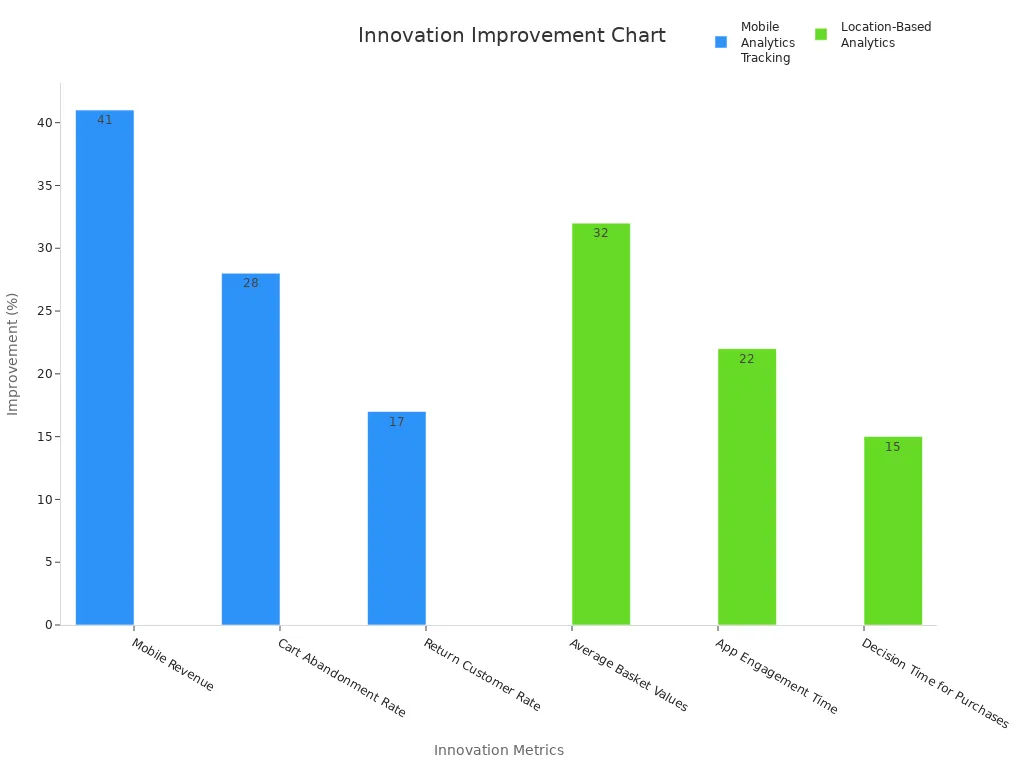Shopping Cart Containment Systems: Preventing Loss and Ensuring Customer Convenience

Shopping cart containment systems play a vital role in modern retail. These systems prevent carts from leaving designated areas, ensuring they remain available for customers. They also enhance your shopping experience by adding convenience and promoting a smoother process. For businesses, these systems reduce costs associated with lost or stolen carts while improving operational efficiency. By balancing security with accessibility, they create a win-win scenario for both retailers and shoppers.
Key Takeaways
Shopping cart systems keep carts in one place to stop theft.
These systems make carts easier to find, helping customers shop happily.
Using these systems saves stores money by stopping cart loss.
New tech like AI and GPS makes shopping safer and easier.
Eco-friendly designs and energy-saving ideas are now part of these systems.
What Are Shopping Cart Containment Systems?
Definition and Purpose
Shopping cart containment systems are tools or technologies designed to keep shopping carts within a store's designated area. These systems prevent carts from being taken off-site, ensuring they remain available for customers while reducing losses for businesses. They also enhance the shopping experience by maintaining a steady supply of carts for use.
The purpose of these systems extends beyond theft prevention. They contribute to operational efficiency, sustainability, and customer satisfaction. The table below highlights their key purposes and impacts:
Purpose/Impact | Description |
|---|---|
Preventing cart theft | The CartControl® system prevents carts from leaving the store, reducing loss and associated costs. |
Maintaining brand integrity | Keeping carts on-site enhances customer perception of the brand in the community. |
Enhancing customer experience | More available carts lead to increased customer satisfaction and potentially higher sales. |
Promoting sustainability | Reduces environmental waste by preventing cart abandonment and damage. |
Financial impact | Full ROI typically within 6-18 months, improving sales and reducing costs from cart loss. |
Cart theft statistics | Approximately 2 million shopping carts are stolen annually, impacting retailers significantly. |
By addressing these areas, shopping cart containment systems provide a comprehensive solution for retailers looking to improve their operations and customer service.
Types of Containment Systems
Shopping cart containment systems come in various forms, each tailored to meet specific needs. Here are some common types:
Wheel-Locking Systems
These systems use electronic mechanisms to lock a cart's wheels when it crosses a designated boundary. Retailers often install an underground wire around the store's perimeter, which interacts with a device on the cart to trigger the lock. This type is highly effective in preventing carts from leaving the premises.Perimeter Barriers
Physical barriers, such as fences or bollards, are another method to contain carts. These barriers restrict carts to specific areas, ensuring they remain accessible to customers while deterring theft or misuse.Cart Corrals
Cart corrals are designated areas in parking lots where customers can return carts after use. While not a high-tech solution, they help keep carts organized and reduce the risk of damage or loss.
Each type offers unique benefits, allowing retailers to choose the best option based on their store layout, budget, and customer needs.
Integration with AI-Powered Solutions Like Cloudpick's Unmanned Store
The integration of shopping cart containment systems with AI-powered solutions is transforming the retail landscape. Cloudpick's Unmanned Store exemplifies this innovation. By leveraging advanced AI and IoT technologies, these stores eliminate the need for traditional shopping carts altogether. Instead, they use virtual shopping carts that track customer selections in real time.
For example, at Shanghai Pudong International Airport, Cloudpick's Smart Unmanned Store allows customers to shop without physical carts. The AI system monitors customer movements and updates their virtual cart automatically. This approach not only enhances convenience but also minimizes shrinkage and operational costs. By combining containment systems with AI-driven solutions, retailers can offer a seamless, secure, and efficient shopping experience.
Cloudpick's technology demonstrates how the future of shopping cart containment systems lies in integrating physical and digital solutions. This hybrid approach ensures security while prioritizing customer convenience, setting a new standard for modern retail.
How Do Shopping Cart Containment Systems Prevent Loss?

Mechanisms of Loss Prevention
Shopping cart containment systems use advanced anti-theft solutions to prevent shopping cart theft and ensure shopping cart safety. These systems rely on innovative mechanisms to keep carts within designated areas and reduce loss. Here are some common methods:
Electronic Locking Systems
These systems use embedded technology to lock a cart’s wheels when it crosses a boundary. For example, underground wires interact with sensors on the cart to trigger the lock. This prevents carts from leaving the premises and ensures their availability for customers.Cart Corrals
Cart corrals provide a designated space for customers to return carts after use. While simple, they help organize carts and reduce the risk of damage or theft. Corrals also promote shopping cart safety by keeping carts accessible and secure.Shopping Cart Coin Lock Systems
These systems require customers to insert a coin to unlock a cart. The coin is returned when the cart is returned to its proper location. This encourages responsible cart use and minimizes abandonment.
The effectiveness of these mechanisms is evident in real-world applications. For instance, supermarkets like Schnuck Stores and Save-A-Lot have reported significant reductions in cart loss after implementing electronic locking systems. The table below highlights their success:
Supermarket Chain | System Used | Cart Loss Before | Cart Loss After | Customer Feedback |
|---|---|---|---|---|
Schnuck Stores | Carttronics | High | None | Improved availability of carts |
Save-A-Lot | KartSaver | 10 per week | Virtually eliminated | Neighborhood satisfaction improved |
These systems demonstrate how technology-driven anti-theft solutions can protect carts and enhance customer satisfaction.
Benefits for Businesses
Shopping cart containment systems offer substantial benefits for businesses. By preventing shopping cart theft, these systems reduce operational costs and improve efficiency. Here are some key advantages:
Cost Savings
Businesses save money by reducing the need to replace stolen or damaged carts. For example, Gelson’s Markets reported only three lost carts in six months after implementing a custom system.Operational Efficiency
Containment systems minimize labor hours spent retrieving carts or managing theft-related issues. This allows employees to focus on other tasks, improving overall productivity.Enhanced Safety
Shopping cart safety extends to employees and customers. Reduced theft incidents create a safer shopping environment, fostering trust and loyalty.Valuable Insights
Some systems provide data on store traffic and customer behavior. This information helps businesses make informed decisions to optimize operations.
The table below outlines the financial benefits of containment systems:
Benefit Type | Description |
|---|---|
Labor & Operational Savings | Reduction in labor hours spent on inventory management and administrative tasks related to theft. |
Recovered Merchandise | Increased recovery of goods due to reduced pushout attempts, leading to less loss. |
Legal Fees | Decrease in legal costs associated with shoplifting incidents and related claims. |
Employee and Shopper Safety | Enhanced safety for employees and customers due to reduced theft incidents. |
Additional Theft Deterrence | Significant reduction in pushout attempts, with up to 80% decrease noted after system installation. |
Valuable Trends and Insights | Access to data on store traffic and behavior, aiding in operational decision-making. |
These benefits highlight how containment systems not only prevent loss but also contribute to a more efficient and profitable business model.
Role of Shopping Cart Safety in Minimizing Shrinkage
Shopping cart safety plays a crucial role in minimizing shrinkage, which refers to the loss of inventory due to theft or mismanagement. Containment systems act as anti-theft solutions, ensuring carts remain on-site and reducing opportunities for theft. For example, electronic locking systems prevent pushout attempts, where thieves use carts to steal merchandise.
By securing carts, businesses can recover more merchandise and reduce shrinkage-related costs. This also improves customer experience, as carts remain available for legitimate use. At Shanghai Pudong International Airport, Cloudpick’s Smart Unmanned Store has demonstrated how AI-powered systems can further enhance shopping cart safety. The store uses virtual carts to track customer selections, eliminating physical cart theft entirely.
When you implement shopping cart containment systems, you protect your assets and create a safer, more efficient shopping environment. This approach ensures that both businesses and customers benefit from reduced shrinkage and improved operational efficiency.
Ensuring Customer Convenience with Shopping Cart Containment Systems

User-Friendly Features
Shopping cart containment systems prioritize ease of use to enhance customer convenience. Features like the locking wheel system simplify the shopping experience. These systems activate automatically when a cart crosses a boundary, ensuring security without requiring extra effort from you. The intuitive design allows you to focus on shopping rather than worrying about cart restrictions.
Retailers also implement best practices for cart security by choosing systems that are easy to operate. For example, coin-lock systems encourage responsible cart use while remaining straightforward. You insert a coin to unlock the cart and retrieve it upon return. This approach ensures carts stay organized and accessible.
Accessibility for All Customers
Accessibility is a cornerstone of modern cart containment systems. These systems cater to diverse needs, ensuring everyone can shop comfortably. ADA-compliant designs make carts usable for individuals with disabilities. Features like ergonomic handles and lightweight construction improve usability for all shoppers.
Family-friendly designs also enhance accessibility. Larger carts accommodate parents shopping with children, while smaller carts suit quick trips. These thoughtful designs ensure you find a cart that meets your needs, regardless of your shopping style.
Enhancing Convenience in Cloudpick's Unmanned Store
Cloudpick's Unmanned Store takes customer convenience to the next level. By eliminating physical carts, it introduces virtual shopping carts powered by AI. As you shop, the system tracks your selections and updates your virtual cart in real time. This seamless process saves time and effort.
At Shanghai Pudong International Airport, Cloudpick's Smart Unmanned Store showcases this innovation. You enter the store using QR codes or facial recognition, shop without physical carts, and enjoy a frictionless checkout experience. The AI system ensures accuracy and efficiency, redefining cart containment in the digital age.
Cloudpick's approach demonstrates how technology can transform cart containment systems. By integrating AI, retailers offer a secure and convenient shopping experience tailored to your needs.
Balancing Security and Accessibility
Addressing Customer Concerns About Restrictions
When shopping cart containment systems introduce restrictions, you might worry about how they affect your shopping experience. Retailers must balance enhanced security with convenience to ensure you feel valued. Research shows that persistent shopping carts reduce abandonment rates by reminding you to complete your purchases. At the same time, security measures like encrypted data storage and compliance with privacy regulations protect your information.
Your concerns often stem from how restrictions impact your freedom while shopping. For example, systems like grocery cart locking wheels may seem limiting. However, these features ensure carts remain available for everyone, improving overall accessibility. Retailers also implement comprehensive safety measures tailored to your needs, such as ergonomic designs and ADA-compliant carts. These efforts aim to address your concerns while maintaining security.
Objective | Description |
|---|---|
Comprehensive Safety Measures | Formulate safety measures tailored for virus containment in retail stores. |
Customer Perceptions | Explore how safety protocols affect customer perceptions, satisfaction, and behavior. |
Strategies for Seamless Integration into the Shopping Experience
To make containment systems work for you, retailers focus on seamless integration. They design systems that blend into your shopping routine without causing disruptions. For instance, grocery cart locking wheels activate automatically when carts cross boundaries, ensuring security without requiring extra effort from you.
Retailers also use technology to enhance your experience. AI-powered systems, like those in Cloudpick's Unmanned Store, eliminate the need for physical carts. Instead, virtual carts track your selections in real time, making shopping faster and more convenient. These strategies prioritize your comfort while maintaining security measures.
Additionally, retailers educate you about how these systems work. Clear signage and staff assistance help you understand the benefits, reducing any frustration. By focusing on user-friendly designs and communication, they ensure you enjoy a smooth shopping experience.
Examples of Successful Implementations, Including Cloudpick's Solutions
Real-world examples highlight how retailers successfully balance security and accessibility. Ahold Delhaize USA introduced a cashier-less micro store called "Lunchbox" at their Carlisle, PA distribution center. This store uses AI and IoT to track products and customer interactions, reducing shoplifting and improving operational efficiency. Employees shop seamlessly using a mobile app, eliminating traditional checkouts.
Feature | Description |
|---|---|
Implementation | Ahold Delhaize USA introduced a cashier-less micro store called 'Lunchbox' at their Carlisle, PA distribution center. |
Technology | Utilizes AI and IoT to track products and customer interactions. |
Operational Efficiency | Reduces shoplifting and improves operational efficiency. |
Customer Experience | Employees can shop seamlessly using a mobile app, eliminating traditional checkouts. |
Cloudpick's Smart Unmanned Store at Shanghai Pudong International Airport offers another example. This store uses virtual carts to track your selections, eliminating physical cart theft. The AI system ensures accuracy and efficiency, creating a frictionless shopping experience. These implementations show how retailers can combine enhanced security with customer convenience.
Future Trends in Shopping Cart Containment Systems
Innovations in Technology (e.g., GPS tracking, app-based systems)
Shopping cart containment systems are evolving rapidly with the integration of advanced technologies like GPS tracking and app-based systems. These innovations enhance both security and customer convenience. For instance, GPS tracking allows you to monitor cart locations in real time, ensuring they remain within designated areas. App-based systems, on the other hand, provide features like cart reservations and digital receipts, streamlining your shopping experience.
Studies show that mobile analytics tracking has significantly improved retail performance. Metrics like mobile revenue increased by 41%, while cart abandonment rates dropped by 28%. Location-based analytics also boosted average basket values by 32% and reduced decision time for purchases by 15%. These advancements highlight the potential of technology to transform shopping cart containment systems.

Retailers are also leveraging surveillance cameras and RFID technology to enhance cart security. RFID tags embedded in carts allow for precise tracking, while surveillance cameras monitor cart usage and deter theft. These tools work together to create a seamless and secure shopping environment.
Sustainability and Eco-Friendly Designs
Sustainability is becoming a key focus in the design of shopping cart containment systems. Retailers are adopting eco-friendly materials like recycled plastics and lightweight metals to reduce environmental impact. These materials not only lower production costs but also extend the lifespan of carts, making them more sustainable.
Energy-efficient locking mechanisms are another innovation. These systems use minimal power while maintaining high performance, reducing the carbon footprint of retail operations. RFID technology also contributes to sustainability by enabling efficient inventory management, which minimizes waste.
Retailers are exploring ways to repurpose abandoned carts. For example, damaged carts can be recycled into new products, reducing landfill waste. These efforts align with global sustainability goals and demonstrate how containment systems can support a greener future.
Predictions for the Evolution of Containment Systems in AI-Driven Retail
The future of shopping cart containment systems lies in AI-driven retail. Innovations like RFID technology and surveillance cameras will play a central role in this transformation. AI algorithms will analyze data from these tools to predict customer behavior, optimize cart availability, and enhance security.
Market trend reports predict significant developments in this sector. For example, regulatory changes and advancements in raw materials will shape the market. The table below outlines key parameters influencing the evolution of containment systems:
Parameter | Description |
|---|---|
Market drivers and restraints | Current and expected impacts on the market. |
Raw material scenario | Analysis of supply versus price trends. |
Regulatory scenario | Expected developments in regulations affecting the market. |
Current capacity | Analysis of existing capacity and expected additions up to 2027. |
Weight assignment | Quantifying the impact of various parameters on market momentum. |
AI-powered systems like Cloudpick's Unmanned Store exemplify this trend. These stores eliminate the need for physical carts by using virtual shopping carts that track your selections in real time. This approach not only enhances convenience but also reduces theft and operational costs. As AI continues to advance, you can expect shopping cart containment systems to become smarter, more efficient, and more customer-centric.
Shopping cart containment systems play a crucial role in modern retail. They help you by ensuring carts remain available while protecting businesses from losses. These systems create a balance between security and convenience, making your shopping experience smoother and more enjoyable.
Tip: Look for stores that use advanced systems like Cloudpick's Unmanned Store. These innovations combine AI technology with customer-focused designs to redefine convenience.
The future holds exciting possibilities. AI-powered solutions will continue to enhance these systems, offering smarter, more efficient, and eco-friendly options tailored to your needs.
FAQ
What is a shopping cart containment system, and why is it important?
A shopping cart containment system keeps carts within designated areas. It prevents theft and ensures carts remain available for customers. This system acts as a deterrent to loss and promotes shopping cart protection, helping businesses save money while improving your shopping experience.
How does a locking mechanism work in these systems?
The locking mechanism activates when a cart crosses a boundary. For example, an underground wire interacts with the cart’s sensor to lock its wheels. This ensures carts stay on-site, providing a secure shopping cart experience for you and other customers.
Are these systems accessible for all customers?
Yes, modern systems prioritize accessibility. They include ADA-compliant designs for individuals with disabilities and family-friendly carts for parents. These features ensure every customer can shop comfortably while benefiting from shopping cart protection and security.
How do these systems deter theft effectively?
Containment systems deter theft by using advanced technologies like electronic locks and GPS tracking. These features make it difficult for thieves to remove carts from the premises, ensuring carts remain available for legitimate use and reducing losses for businesses.
Can AI-powered solutions replace traditional shopping carts?
Yes, AI-powered solutions like Cloudpick’s Unmanned Store eliminate the need for physical carts. Virtual carts track your selections in real time, offering a seamless and secure shopping cart experience. This innovation enhances convenience while acting as a deterrent to theft.
See Also
Navigating Walgreens Self-Checkout: Benefits and Hurdles in Shopping
Discovering How Cloudpick Offers Cashier-Free Shopping Ease
Addressing Self-Checkout Cash Mistakes: Reasons and Remedies
